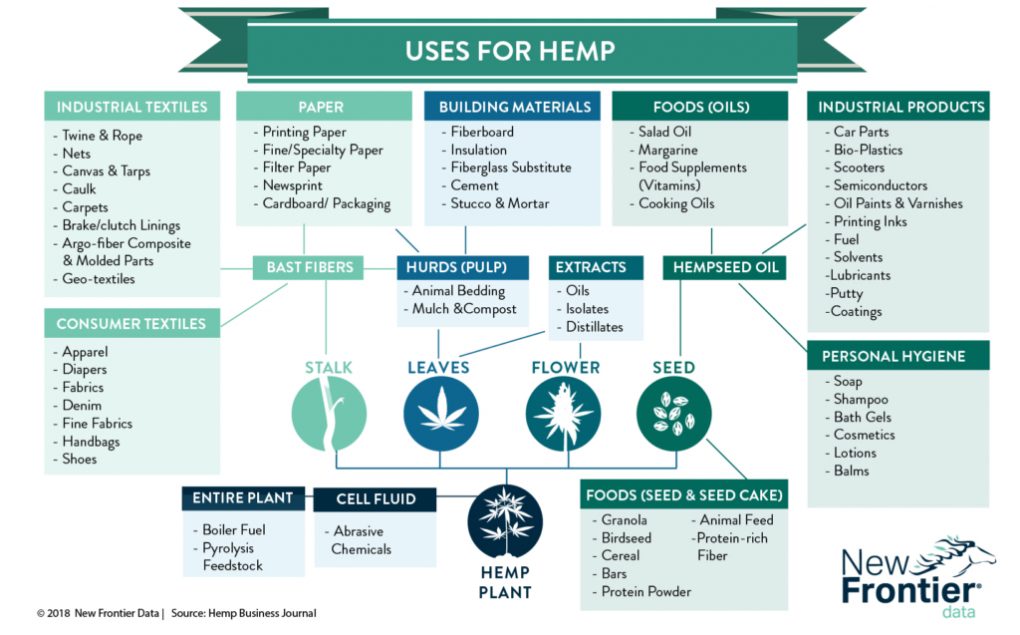Ever heard of industrial hemp? Sounds pretty badass, right? Well, that’s because it is. Let me explain.
Industrial hemp is an agricultural commodity (staple crop grown on a farm/plantation) which is cultivated for the production of a variety of manufactured goods ranging from textiles, to insulation, to nutritional supplements, to personal care products and much more. This might sound quite dull if you care little about agriculture or sustainability, but this plant is literally referred to as “The God Plant.” In my opinion, the name is quite fitting – industrial hemp is an extremely versatile crop – and at our striking rate of resource depletion, having a renewable resource with a plethora of applications sounds like a Hail-Mary to me. But there’s one problem: people don’t know that there’s a major difference between hemp and marijuana; that it’s actually impossible to get high off of hemp (it’s rope, not dope, man.) And it’s this misunderstanding that has strained the growth of industrial hemp in our country for quite some time.
This ignorance is especially true for politicians — thanks to the old guys that umbrella-termed hemp and marijuana, cultivating hemp was outlawed until 2014 (just for research purposes) due to it being coined as a ‘controlled substance’ by the DEA. So here’s the funny story — hemp and marijuana are extremely different. While the two come from the same species of plant (Cannabis sativa), they are genetically-distinct varieties of the plant that have been bred for different purposes. Hemp and marijuana can be distinguished not only from their differing physical attributes, but from their chemical makeup, cultivation practices, and general uses. Hemp, unlike marijuana, does not need to be grown in a controlled environment, grows in large stems as tall as 20 feet, and requires little care, being able to thrive on infertile soil. But the funniest part is that hemp contains only 0.3% THC or less – this means hemp has no psychoactive properties, obviously differing from its counterpart which contains 5-35% THC. (Sorry guys, you can’t get high off that bottle of hemp milk you bought from Trader Joe’s last week.) But thankfully, times are-a-changing and new bills that are less strict on hemp farmers are under review. Now let me show you why hemp and sustainability are a match made in heaven!

(Source: Canna Connection)
Industrial hemp can be cultivated to produce over 50,000 products that fall under 9 submarkets: agriculture, textiles, recycling, food and beverages, paper, construction materials, automotive, and personal care. But what makes hemp so special is not only the wide variety of markets it can fit under, but how almost every single part of the hemp plant can be utilized – from the stalks, to the seeds, and to the leaves, each part of the plant has a purpose.
On top of having over 50,000 uses, what really makes industrial hemp such an incredible crop is its sustainable attributes. Because hemp grows like a weed (meaning it grows and spreads at a rapid rate), it makes a great source for paper – compared to the 20 years it takes for trees to produce paper to mature, it only takes 20 weeks until the hemp crop can be harvested. Moreover, it can replace corn for ethanol production; not only is hemp resistant to pesticides, but it uses only one-third of the water used to produce corn. Biofuel diesel made with hemp seed oil also grows well on infertile soil and has very low sulfur dioxide emissions. The cultivation of industrial hemp to create textile fibers also demonstrates the sustainable attributes of the plant, as it is renewable and only requires half of the water used to produce cotton. (I mean, as a sustainability major, this crop is like GOLD. I’m telling you when I did research on this topic last spring, I was like a kid in a candy store but instead of a kid just an enviro-geek and the candy store being a 48-page study. It’s good stuff, guys – I’m telling ya’.)

(Source: New Frontier)
Hemp is also considered to be an extremely nutritious superfood; it acts not only is a plant-based protein option for vegans/vegetarians, but contains a balanced ratio of fatty acids, all 10 amino acids, and a multitude of beneficial vitamins such as vitamin E. Moreover, the plant also contains anti-inflammatory, anti-aging, and oil-regulating properties which make hemp a beneficial resource for natural skincare products. (I mean, not to mention CBD which you can find in just about ANYTHING on Melrose Avenue. Hit up Alfred and get yourself a vegan, CBD-infused, nitro cold brew ‘chagaccino’ for the sweet, sweet price of $7.80.)
I mean, what more can I say – industrial hemp is a badass, sustainable agricultural commodity. Try and name another plant that can do all this. Seriously, go ahead. That’s what I thought. But regardless of how badass this plant is, we seriously need to support it. Next time you’re at the store and you see a hemp alternative to a product you typically buy, try and get it! Even just clarifying the distinction between hemp and marijuana is making a difference in itself – anything helps!
Source: U.S. Congressional Research Service. Hemp as an Agricultural Commodity (RL32725; June 22, 2018), by Renée Johnson. Text in: Congressional Research Service; https://fas.org/sgp/crs/misc/RL32725.pdf.

